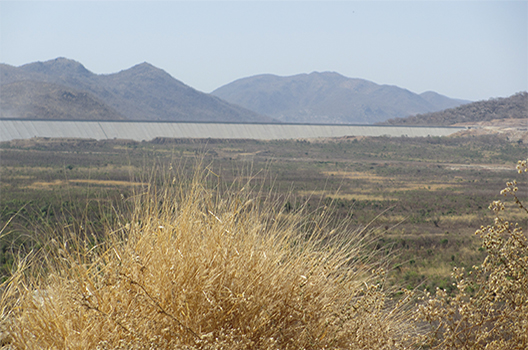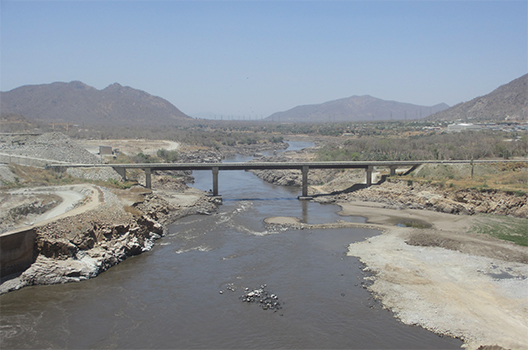Grand Ethiopian Renaissance Dam marks milestone, approaches completion
The April 2 anniversary of the laying of the foundation stone of the Grand Ethiopian Renaissance Dam (GERD) in 2011 passed largely unremarked amid the cascade of momentous news coming recently from Ethiopia, including several years of unrest, the sudden release of thousands of detainees in mid-February, the resignation of the prime minister one day later, the declaration of a state of emergency the day after that, as well as the ensuing intense deliberations within the governing Ethiopian People’s Revolutionary Democratic Front, culminating in the election of a new coalition chairman and his swearing-in this week as prime minister, the first such constitutional handover in the millennial history of the Ethiopian state. Yet it would not be an exaggeration to say that, as the GERD approaches completion, its strategic geopolitical and socioeconomic impact on Ethiopia and, indeed, the entire Northeast Africa region may prove greater than of any of the developments that have lately filled the news.
As its name suggests, the GERD is not just an infrastructure project, but was also conceived as a statement about Ethiopia’s vision for and commitment to its own development. From the onset, the construction was financed by neither international finance institutions nor donor countries, but by bonds purchased by Ethiopians at home and abroad. The project itself is directly managed by Ethiopian Electric Power, with the Italian construction firm of Salini Impregilo and the Metals and Engineering Corporation of Ethiopia as the two main contractors and a Franco-Italian joint venture of Coyne et Bellier and ELC Electroconsult retained as consultants. As I learned during a visit last month to the site in the Benishangul-Gumuz region of western Ethiopia near the border with Sudan, of the roughly 9,000 people working on the project, only about 250 are expatriates, hailing from some two dozen countries—the overwhelming majority of those employed are Ethiopians, including Engineer Semegnew Bekele, the overall manager, who was my guide.
As a feat of engineering, the GERD is awe-inspiring. Spanning the Blue Nile, the source of some 85 percent of the combined river’s flow (the White Nile, which begins in Lake Victoria, contributes just 15 percent of the total flow once it meets the Blue Nile in Khartoum, Sudan), the 145-meter high roller-compacted concrete structure is 1,870 meters across that, along with an additional saddle dam spanning 5,200 meters, will eventually contain a reservoir covering 1,874 square kilometers. The two outdoor powerhouses are equipped with sixteen power-generation units, for an installed capacity of 6,450 MW.

The GERD is hardly Ethiopia’s first hydropower project—the country has honed its skill with numerous earlier projects, including the Gilgel Gibe I, II, and III dams on the Gilgel Gibe and Omo Rivers in the southern Ethiopia—the dam is its most significant undertaking to date and will be Africa’s biggest electric power producer and the seventh largest in the world. By providing a constant supply of clean and affordable power to the nation, Africa’s second most populous, the GERD has the potential to accelerate Ethiopia’s transformation from a largely agricultural economy to an industrial powerhouse (already, due in large part to East Asian investments, Ethiopia has in just a few years become a major exporter of shoes made from the country’s abundant animal hides).
In addition, the GERD will have spillover effects benefiting the wider region. The extensive transmission lines, many of which are already in place, connecting Ethiopia with Sudan, Djibouti, and Kenya will make power available to these neighbors. With the potential to produce even more power from the abundant water flows from its highlands, Ethiopia will be in the position to meet a large part of the energy needs of Sub-Saharan Africa and North Africa through cheaply and cleanly generated electricity. Moreover, the completed dam’s promise of regulated water throughout the year will be a boon to neighboring Sudan’s agricultural potential, especially in the Gezira region south of Khartoum, between the confluence of the Blue Nile and the White Nile (the area hitherto has been subject to an annual flood followed by harsh dry seasons), as well as increasing the energy the downstream country will be able to produce with its existing hydropower installations.

All this is not to say that the GERD is not without controversy. Egypt, whose President Abdel-Fatah al-Sisi was seeking the ratification of a second term in office in voting held March 26-28, has expressed alarm over the possibility that the dam would result in a diminution of the amount of water it has historically taken from the Nile under a pair of colonial-era treaties that Ethiopia was never a party to, declaring that the river was “a matter of life and death” for his country and that “no one can touch Egypt’s share of the water” (some experts have suggested that the real preoccupation is that if Sudan is able to use its full allocation under the pacts because of the regulated flow that the GERD will ensure, then Egypt would find the amount of water available to it would be reduced significantly, even if still the volume that crossed its border was the amount stipulated). Fortunately, now that the Egyptian electoral campaign has wrapped up—and with it, some of the heated rhetoric that has been thrown about in recent months—it appears that the sides are ready to resume discussions, with the foreign affairs and water ministers of Egypt, Ethiopia, and Sudan scheduled to convene in Khartoum later this week.
The challenge will be navigating between the apparent conflict between the interests of two of Africa’s oldest and puissant states and arriving at a win-win solution. A guiding principle for such a resolution is already contained in the Cooperation Framework Agreement that six countries in the Nile Basin (Burundi, Ethiopia, Kenya, Rwanda, Tanzania, and Uganda) have signed: “Nile Basin States shall in their respective territories utilize the water resources of the Nile River system and the Nile River Basin in an equitable and reasonable manner. In particular, those water resources shall be used and developed by Nile Basin States with a view to attaining optimal and sustainable utilization thereof and benefits therefrom, taking into account the interests of the Basin States concerned, consistent with adequate protection of those water resources. Each Basin State is entitled to an equitable and reasonable share in the beneficial uses of the water resources of the Nile River system and the Nile River Basin.”
J. Peter Pham is vice president of the Atlantic Council and director of its Africa Center.
Image: The Grand Ethiopian Renaissance Dam (GERD) nearing completion (Atlantic Council/J. Peter Pham)
